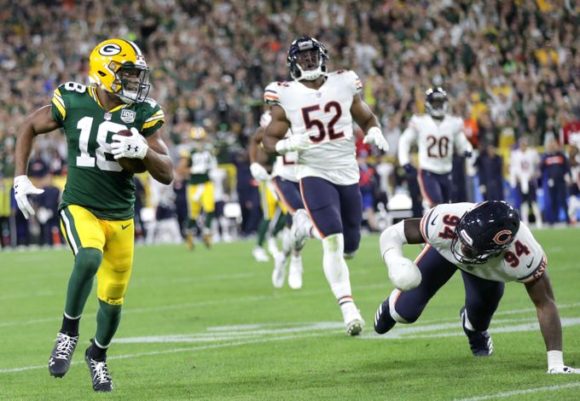The Green Bay Packers kicked off their 100th season with a thrilling 24-23 come-from-behind victory over the rival Chicago Bears. The home team was dominated for the entirety of the first half, and fans were subjected, if only briefly, to feelings of despair at the prospect of losing Aaron Rodgers for a second straight season. But lo and behold, #12 defied the odds and returned to action after halftime to orchestrate yet another career-defining moment for his Hall of Fame resumé.
While Rodgers’ performance was unquestionably a significant factor, it is essential to acknowledge that the second half turn-around would not have been possible without some other key moments and performances–and some incredibly good luck.
As Packer fans are already well aware, the 2018 season did not start off as planned. Second-year quarterback Mitch Trubisky marched the Bears down the field, covering 86 yards in 10 plays to put the Bears on top 7-0. And even before Rodgers’ injury, the Packers floundered, punting four times and recording just one first down in their first four drives. Khalil Mack and the Bears’ defense were running wild, looking even better than the top 10 unit Chicago fielded a year ago.
Then, disaster hit. Rodgers suffered a knee injury on a sack, one that initially appeared to be serious. DeShone Kizer’s first two meaningful drives ended in turnovers, including a pick-six by Mack. The game was 17-0 at the half, a lead the Bears quickly extended to 20-0 in the third quarter. Then the offense, led by a clearly hobbled Rodgers, took over, outscoring Chicago 24-3 to close out the game.
So what changed? The Bears dominated Green Bay to start–even with Rodgers–then couldn’t shut the Packers down even after Rodgers’ mobility was limited. A big part of the comeback that should not be overlooked was the second half play of Bryan Bulaga, David Bakhtiari, and the rest of the offensive line. Chicago recorded four sacks in the first half, two each on Rodgers and Kizer.
But Rodgers was kept relatively clean after halftime, getting hit a few times without being taken to the ground. Khalil Mack, after wreaking havoc to start the game, was rendered ineffective in crunch time, recording just a single tackle in the second half. Mike McCarthy deserves some of the credit there as well, calling plays exclusively out of shotgun and pistol formations that allowed Rodgers to get rid of the ball quickly.
On a smaller scale, running backs Jamaal Williams and Ty Montgomery made some key plays that won’t necessarily show up on a stat sheet. They both averaged under four yards per carry, but excelled at pass protection when it mattered most. And Montgomery made two huge downfield blocks on Randall Cobb’s game winning touchdown.
Speaking of Cobb, the 8th year receiver turned in one of the best games of his life, setting a new career high with 142 yards after an offseason in which many Packer fans supported cutting ties with #18. He had a game-high nine catches as well, five of which resulted in first downs.
Mike Pettine’s defense also deserves a significant part of the credit for Green Bay’s ability to come back and win the game. After looking pretty rough on the Bears’ first drive, the Packers’ defense kept Chicago out of the end zone for the remainder of the game. They allowed only a trio of field goals, and shut down the Bears on eight plays after Clay Matthews inexplicably and inexcusably gave Chicago life with a late roughing the passer penalty. Trubisky managed a paltry 171 yards on 35 attempts (a meager 4.9 ypa). Pettine and the secondary showed a lot of positives to build on, especially given they got little help from the pass rush.
Other single moments had key impacts on the game, like Geronimo Allison making a difficult catch in the end zone and Davante Adams saving some time by juking Prince Amukamara out of his shoes to draw the Packers within three. But it’s also important to acknowledge that some good luck and bad decisions helped get Green Bay a victory; even Rodgers’ heroics would have likely otherwise fallen short.
One call that will not sit well was first-year coach Matt Nagy’s decision to pass on 3rd and 1 from the Packers’ 14 yard line with less than three minutes left in the game. A first down would have all but ended the game, allowing Chicago to run out most the clock. And Bears’ running back Jordan Howard had had his way with the Green Bay run defense, averaging more than five yards per carry. If Chicago runs it there with Howard, chances are the game ends in a Bears win.
A few plays later, the Packers lucked out again. On the first play of the would-be game winning drive, Davante Adams fell over and Rodgers’ pass hit cornerback Kyle Fuller right in the chest. A gimme-interception that would have ended the game fell harmlessly to the ground, and Cobb had his 75-yard run two plays later. But that’s how games tend to go; missed plays and calls that seem questionable in hindsight have big effects on the outcome.
The Packers now await updates on the severity of Rodgers’ injury. But for one game at least, Green Bay’s quarterback was able to remind the NFL that he’s among the best of the best–even on one leg. If the team, on both sides of the ball, can avoid slow starts and play like they did in the second half against Chicago, the Packers will be set up for a successful 2018 campaign.
——————Sean Blashe is a Packers fan who grew up in Bears territory and is currently a journalism and history major at Marquette University. Sean is a writer with PackersTalk.com and you can follow him on twitter at @SeanBlashe .
——————

